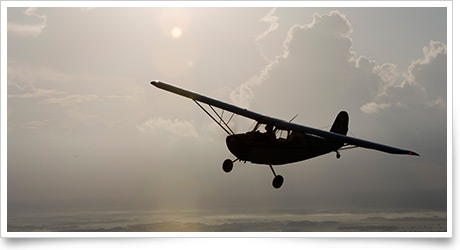| The following stories from the June 29, 2012, edition of AOPA ePilot were provided to AOPA members who expressed an interest in the particular subject areas. Any AOPA member can receive information tailored to their areas of interest by updating their preferences online |
training tipsHigh dew point, hidden hazard
In one such place, this seemingly benign weather observation was registered later in the day that the heat had peaked: 201453Z 36008KT 10SM FEW100 28/21 A2991 RMK AO2 SLP125 6//// T02830211 56010.
With light winds from the north, good visibility, and only a few clouds at 10,000 feet, what was not to like about the conditions?
The temperature (in the low 80s, converted from 28 degrees Celsius) was high but no longer extreme. The single note of caution for alert pilots lay to the right of the slash (/) in the 28/21 temperature and dew-point values given in the observation.
“A high dew point is bad news, usually,” said AOPA Pilot Editor at Large Thomas A. Horne. “A high dew point equals more moisture in the air. More moisture equals more potential warming of the atmosphere, and therefore, instability.”
And atmospheric instability is closely associated with the potential for thunderstorms.
“Once thermals, fronts, and other lifting forces go to work on air masses with high dew points, towering cumulus or cumulonimbus clouds can soon follow,” Horne wrote in the AOPA Pilot article “Wx Watch: Dew Point Review.” “Cooling takes place as moisture-laden air is lifted higher and higher in unstable air masses. Most severe thunderstorms (those with 50-plus-knot surface winds, three-quarter-inch hail, or tornadoes) happen in air masses with dew points above 70 degrees F (21 degrees C).” The Air Safety Institute’s WeatherWise: Air Masses and Fronts online course further explores the role of dew point in weather development.
High dew points may also be a harbinger of imminent frontal passage, as southerly flows pump moisture-laden air into the area, he said.
But not always. A high dew point may not be a match for extremely high temperatures. On a day when the temperature and dew point at AOPA headquarters in Frederick, Md., stood at 37/21 Celsius, Horne was not expecting convective activity.
“There isn’t enough moisture to make a TRW because the high temps have dried the air,” he said.
Horne reminded pilots of another cause for caution on days when the number to the right of the slash is high: The potential for carburetor icing increases because there is more moisture that could freeze in the venturi of an aircraft engine’s carburetor. training productsiPad briefcase from Sporty’sSporty’s has introduced a briefcase designed to work as a flight bag for your iPad. The iPad briefcase includes internal and external pockets for holding accessories such as a charging cable, cleaning cloth, backup battery, or stylus. It can be carried via two handles or a detachable shoulder strap. The bag measures 12 inches by 9 inches by 2 inches. It sells for $39.95. Order online or call 800/776-7897.
Note: Products listed have not been evaluated by ePilot editors unless otherwise noted. AOPA assumes no responsibility for products or services listed or for claims or actions by manufacturers or vendors. final examQuestion: Why are pilots encouraged to use supplemental oxygen above 10,000 feet msl during the day, and 5,000 feet msl at night?
Answer: The major concern is hypoxia and its effect on night vision. Hypoxia is a deficiency of oxygen in the body. Some common symptoms of hypoxia include drowsiness, headache, impaired judgment, dizziness, reduced peripheral vision, tingling in fingers and toes, and a feeling of euphoria. Hypoxia also impairs night vision. Because the rods in the eye, which give us night vision, require sufficient oxygen, a lack of oxygen causes visual impairment. For more information on hypoxia and other aeromedical factors, see Section 8-1-2 of the Aeronautical Information Manual (AIM) as well as AOPA’s subject report about high-altitude flying and the effects of hypoxia. Also, read how hypoxia doomed a Piper Arrow in this Air Safety Institute Safety Spotlight.
Got a question for our technical services staff? Email [email protected] or call the Pilot Information Center, 800/872-2672. Don’t forget the online archive of “Final Exam” questions and answers, searchable by keyword or topic. |
 While much of the country baked in a recent heat wave, temperatures soared to near-record levels in places where truly hot conditions may be experienced only a few days a year.
While much of the country baked in a recent heat wave, temperatures soared to near-record levels in places where truly hot conditions may be experienced only a few days a year.

